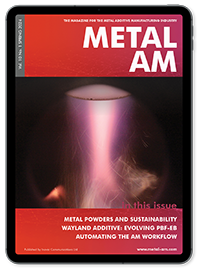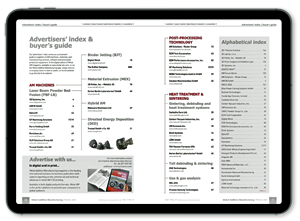For a country with a total population significantly smaller than that of cities such as London or New York, New Zealand is ‘punching above its weight’ when it comes to developing expertise in Additive Manufacturing and educating design engineers in how to use it. Olaf Diegel, a professor at New Zealand’s University of Auckland and associate consultant at Wohlers Associates, and Terry Wohlers, president of Wohlers Associates, report on AM activities and highlight a novel range of successful commercial applications. [First published in Metal AM Vol. 6 No. 3, Autumn/Fall 2020]
... Read more »
The use of metal Additive Manufacturing for the production of injection moulding tools that have been optimised by conformal cooling is growing internationally. For many companies, however, the main obstacles to adoption are not concerns about material properties or apprehension about unfamiliar processes, but simply initial cost – the tooling industry is extremely competitive and AM inserts can be expensive. Here, 3D Systems’ Mark Cook and GF Machining Solutions’ Dogan Basic present a case study from leading toolmaker and injection moulding specialist TK Mold that highlights how such inserts, when efficiently manufactured, can reduce overall manufacturing costs and improve part quality. [First published in Metal AM Vol. 6 No. 3, Autumn/Fall 2020]
... Read more »
When you mix a childhood obsession with rockets and space travel, a career at some of the biggest global names in aerospace, and a curiosity about hobbyist 3D printing developed through maker fairs, it was inevitable that FormAlloy’s Melanie Lang would end up in the world of metal Additive Manufacturing. Metal AM magazine’s Emily-Jo Hopson-VandenBos interviewed Lang, CEO and co-founder of Directed Energy Deposition (DED) specialist FormAlloy, about her route into AM, her company’s technology and the outlook for the process. [First published in Metal AM Vol. 6 No. 3, Autumn/Fall 2020]
... Read more »
Whilst Additive Manufacturing is undoubtedly having a huge impact on the design and manufacture of rocket propulsion systems, most notably combustion chambers and nozzles, the Achilles’ heel of most AM processes is as-built surface finish. Whilst in many AM applications surface finish may be largely irrelevant to a component’s function or performance, when it comes to high-cycle fatigue properties, achieving the required level of smoothness is critical to performance. In this article, Justin Michaud, REM Surface Engineering, reports on advancements achieved in this area through a public-private partnership with NASA. [First published in Metal AM Vol. 6 No. 3, Autumn/Fall 2020]
... Read more »
The story of Atherton Bikes stands out as a shining example of how metal Additive Manufacturing can be successfully embraced and commercialised by a small, dedicated team of people. In the case of the Atherton family, the technology has not only enabled them to maximise their performance at the pinnacle of professional mountain biking, but has also opened a path to commercial bike production in an industry where frame manufacturing is dominated by Taiwan and China. In an article that will appeal to anyone considering the use of metal AM, the Atherton Bikes team shares its experiences with Robin Weston. [First published in Metal AM Vol. 6 No. 3, Autumn/Fall 2020]
... Read more »
It is far too easy to overuse superlatives when speaking about hypercars or Additive Manufacturing. When the discussion combines both – Bugatti’s new driver-focused Chiron Pur Sport and a high-performance AM component that truly pushes today’s processes to their limits – the result is worthy of a closer look. In the following in-depth case study, Bugatti and APWORKS explain the requirements, development and production of the Chiron Pur Sport’s exhaust finisher and share insight into some of its hidden details, from lattice structures to nature-inspired honeycomb reinforcements. [First published in Metal AM Vol. 6 No. 2, Summer 2020]
... Read more »
Rich in creativity and rooted in a long artisanal manufacturing heritage, one would imagine that there can be few sectors as perfectly suited to embrace the potential of metal Additive Manufacturing than the jewellery industry. In reality, however, the sector continues to hold back on the full-scale adoption of AM, despite numerous successes. In this article, Michela Ferraro-Cuda considers progress to date in the adoption of precious metal AM in the jewellery industry, and showcases a number of leading designers who have leveraged the technology’s potential for innovation and differentiation. [First published in Metal AM Vol. 6 No. 2, Summer 2020]
... Read more »
The fourth Metal Additive Manufacturing Conference (MAMC 2019), organised by the Austrian Society for Metallurgy and Materials (ASMET), took place in Örebro, Sweden, from November 25–27, 2019. The event, which attracted an international audience, covered a broad range of metal AM technologies and considered the technical challenges that need to be overcome to make the industry more economically competitive with conventional manufacturing. Prof Dr Jürgen Stampfl, Prof Nader Asnafi, Dr Bruno Hribernik, and Dr Gerhard Hackl review the event for Metal AM magazine.
... Read more »
During the Euro PM2019 Congress and Exhibition in Maastricht, the Netherlands, this October, a number of Special Interest Seminars were held focusing on various aspects of the Powder Metallurgy and Additive Manufacturing industries. In one seminar, Dr Uemit Aydin, GKN Additive, and Nicholas Turner, Materials Solutions, looked to the future of Additive Manufacturing and expressed their views on its industrialisation. David Whittaker attended the SIS on behalf of Metal AM magazine and reports on its conclusions.[First published in Metal AM Vol. 5 No. 4, Winter 2019]
... Read more »
The wide potential of Additive Manufacturing in the oil and gas and maritime sector has come to be widely accepted, with the technology offering significant advantages in terms of lead time, part weight, part count, higher levels of geometric complexity and new material properties. However, in these safety-critical industries, there remain some concerns regarding the quality of AM parts. A Joint Industry Project (JIP), begun in January 2018 and consisting of twenty partners, aims to deliver a new JIP Guideline on Additive Manufacturing for this sector. Here, DNV-GL’s Harsharn Singh Tathgar and Berenschot’s Onno Ponfoort report on the guideline’s development. [First published in Metal AM Vol. 5 No. 3, Autumn 2019]
... Read more »
Whilst the principles of Design for Additive Manufacturing (DfAM) may suggest ‘clean-sheet’ components are the best way to reap the benefits of AM technology, many examples of redesigns have brought significant performance and economic benefits. In this article, Ray Huff and Terry Wohlers report on further success at Siemens in the use of AM for gas turbine fuel swirlers, highlighting both the development process and the evolving role of digital data in manufacturing.
... Read more »
In 2016 SAP and UPS announced their collaboration to develop a supply chain management solution that spans the complete AM process chain, from component evaluation and design to delivery of the final product. Leading US-based AM service provider Linear AMS, a Moog company, is one of several manufacturers involved in the venture. Linear AMS’s Bruce Colter and Moog’s George Small review the drivers behind on-demand manufacturing and present recent developments in materials, applications and component verification.
... Read more »





Join our community